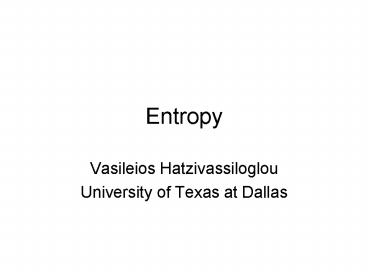Entropy PowerPoint PPT Presentation
1 / 16
Title: Entropy
1
Entropy
- Vasileios Hatzivassiloglou
- University of Texas at Dallas
2
Relationship between Zipfs and Paretos laws
- Two equivalent statements
- The rth type has frequency f
- r types have frequency f or more
- Starting from Zipfs law, we obtain
- nP(X gt f) types have frequency f or more
- nP(X gt f) f is constant
- (nc1f-k) f is constant, which holds for k1
- Zipfs law is a special case of Paretos law
3
Zipf-Mandelbrot law
- Zipfs law f Pr-1
- Overestimates for high frequencies,
underestimates for middle frequencies - Mandelbrot proposed additional parameters
- f P(r ?)-B
- Extra parameters allow for a closer fit
- This is known as the parabolic fractal
distribution
4
Entropy
- The entropy (or information) of a probability
distribution P is - with b gt 1 (usually b2)
- is known as the surprisal of outcome
s, so entropy is the expected value of the
surprisal
5
Entropy examples
- A source that generates the same symbol over and
over - we define 0log0 0 since
- A uniform distribution with n outcomes
6
Interpretation of entropy
- The information contained in the distribution P
(the more unpredictable the outcomes, the higher
the entropy) - The message length if the message was generated
according to P and coded optimally - Relationship with thermodynamics
7
Entropy for multiple variables
- So far we have dealt with a single random
variable - The joint entropy of a pair of two RVs is
8
Conditional Entropy
- How much information do we gain (out of H(X,Y))
if we already have knowledge of one variable? - The conditional entropy is
9
Chain rule for entropy
- H(X,Y) H(X) H(YX)
- H(X1,X2,...,Xn) H(X1) H(X2X1)
H(XnXn-1,Xn-2,...,X1) - Follows from the chain rule for conditional
probabilities the product becomes a sum because
of the logarithm
10
Entropy of a process
- The entropy rate of a stochastic process for
messages of length n is - The entropy rate of the process Xn is
11
The Shannon-McMillan-Breiman Theorem
- Is it ever possible to calculate Hrate?
- If the process Xn is both stationary and
ergodic, the theorem states that for any one
sample X1,X2,...,Xn
12
Estimating P(X1,X2,...,Xn)
- We use the chain rule of conditional
probabilities to decompose this to a product of
conditional probabilities P(Xi Xi-1,
..., X1) - Then, we can directly estimate the conditional
probability using human subjects (Shannons
original approach) - Or we can approximate with Markov chains
13
Markov chains
- A subtype of random walks where the entire memory
of the system is contained in the current state - Described by a transition matrix P, where pij is
the probability of going from state i to state j - Very useful for describing stochastic discrete
systems
14
Markov chain states
- Can correspond directly to the individual
decisions/states for the problem at hand - Can combine multiple successive problem states in
one Markov Chain state - This allows for the MC to remember more than one
(but a finite number of) problem states - Number of parameters increases exponentially with
the order (number of combined states) of the chain
15
The Markov approximation
- For a (stationary) Markov chain of order k,
- Also known as n-gram models (with nk1)
- The 0-th order Markov chain is
- The prior probability of each state P(X)
16
Reading
- Sections 2.2.1-2.2.2 on entropy and conditional
and joint entropy

